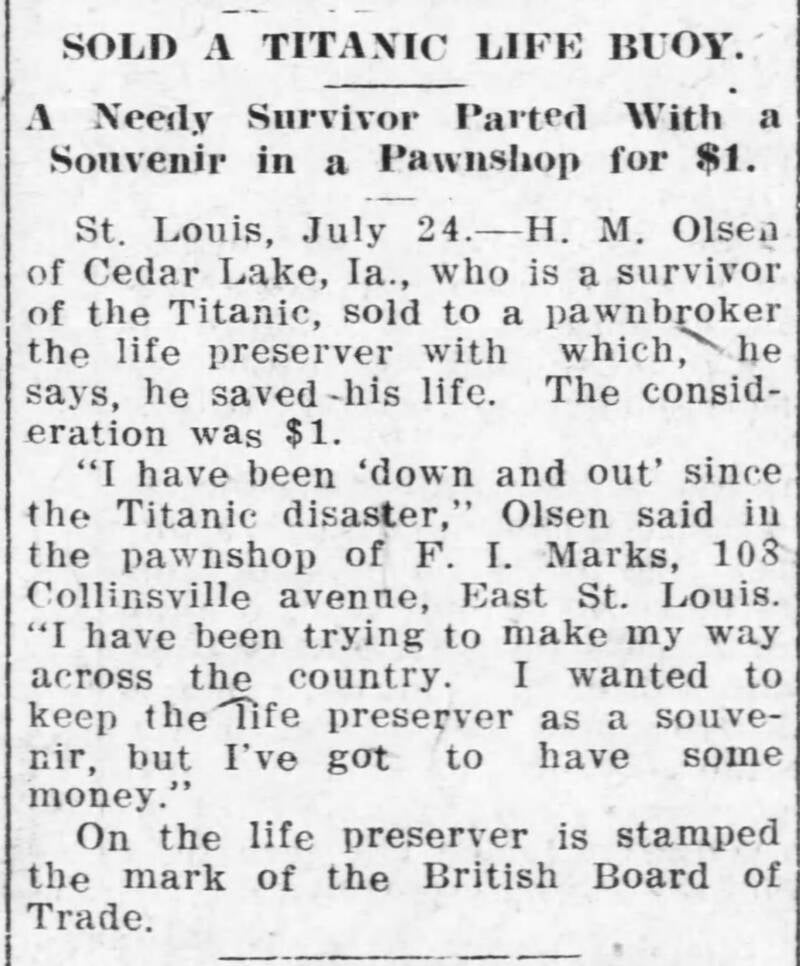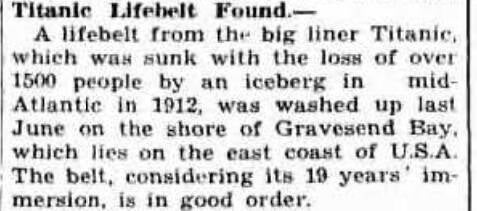questionable Titanic lifebelts
Sometimes items coming from elsewhere have been misidentified as coming from the Titanic.
This was already happening as early as 1912, as can be read in many newspaper articles.
While researching the lifebelts I discovered a small newspaper clipping mentioning a survivor selling his lifebelt for one dollar. Fellow researcher Günter Bäbler found another article which offered some more information. The survivor gave his name as being H. M. Olsen of Cedar Lake, Iowa.
After checking Titanic's passenger list, Mr Bäbler found only one passenger with this name: Henry Margido Olsen, but he died in the sinking. The only survivor by the name of Olsen was Arthur Carl Olson, but he was a child at only nine years old.
Added to this information, there appears to be no place called Cedar Lake in Iowa. There is, however, a Cedar Lake in Cedar Rapids, Iowa. The only Titanic link to Cedar Rapids is Mr. and Mrs. Douglas, and again, Mr. Douglas actually died in the sinking. Could somebody have made up a story? It would appear as such.
Another newspaper article, published in the St. Louis Star and Times of Friday, July 5th, 1912, mentioned the following:
“After the owner of the preserver had gone, who gave his name as H. M. Alsom,(…) Marks put the article on the outside of his store with a sign announcing to curio collectors that he would sell the only life preserver saved from Titanic if he could get a reasonable bid for it. The people of East St. Louis however refuse to take his offer seriously, and Marks is beginning to wonder whether or not he was 'taken in' by the stranger.”
An article published in the St. Louis Post Dispatch of Friday, July 5th, 1912, gave more details about the lifebelt. Here it is stated that “The stranger (…) told Marks he belted the preserver around his waist”, while Titanic's lifebelts where the newer “overhead”-type lifebelts.

Article from the Chanute Daily Tribune, Wednesday, July 24th 1912.
Lifebelt saved by a Mackay-Bennett crewmember (half)
A Mackay-Bennett crewmember purportedly saved half of a lifebelt that was cut from the body of a Titanic victim. It was to be auctioned on June 10th, 2004, by Guernsey’s in New York for an estimate of $30,000 to $40,000 USD. The lifebelt did not sell during auction but was sold privately after the auction had ended. It is currently owned by the Pigeon Forge / Branson Titanic Museum Attractions. The half lifebelt has its bottom two cork blocks missing, and it doesn’t have straps.
After close examination in 2018 it was noted that this lifebelt appeared to be made from cotton instead of the usual distinctive linen seen on all other bonafide Titanic lifebelt examples. Further examination showed that the remaining cork pockets do not have the same aspect ratio (height vs. width) found in other known Titanic lifebelts, that the side stitching is atypical compared to others and that an incorrect stitching method had been used previously to sew up the bottom and then removed. With image magnification it was shown that the lifebelt's side stitching had also been in another different position in the past, at one point being significantly tighter and more ‘pulled in’ which would have therefore made the pockets much smaller and narrower than any known examples. It had been theorized, by a previous owner, that perhaps the original cork blocks had been replaced with modern cork which may possibly explain the unusual current side stitching, but not the other outlying factors. Added to this, the provenance of the lifebelt has come into question, at one point being described as “identical in appearance to Titanic lifebelts” and at another time as a bonafide Titanic lifebelt. Due to the many issues this lifebelt has presented, it did not meet or pass the very high threshold that has been set in order to authenticate it as either a known Titanic or a Fosbery & Co. lifebelt, and it has therefore been decided to not include it among the list of fully authenticated, bonafide lifebelts, but instead add it to this list of questionable ones.

The Weinke lifebelt
The Wisconsin State Journal of April 5th, 1998, mentioned another Titanic lifebelt. It was bought for a dollar in an estate sale ten years earlier by Michele Weinke, who then wrote to museums wanting to sell or donate the belt. But it was deemed a hoax; it was felt that there would be no lifebelt off Titanic in the United States, let alone Wisconsin. Weinke took it to a home show where antiques were being appraised. Here it was said to be $150 to $175 USD in worth. The next day the appraiser said in a radio interview that the lifebelt could be worth $25,000 with the then current high interest in the Titanic.
They tried to find out how the old cork and canvas lifebelt came to Wisconsin. Delving through old newspapers they found that several Titanic passengers came from the Wisconsin area. It was theorized that one of the bodies was sent home still wearing its lifebelt.
Taking a look at the lifebelt, it is dated May 20th, 1910. It is a lifebelt to be worn around the waist, and the name "WHITE STAR LINE" and "TITANIC" were written on it instead of stamped. But as we have seen earlier, Titanic lifebelts did not carry the ship's name, and it is the wrong style.
It certainly is a real 1910’s lifebelt, just not from Titanic.

Four other lifebelts
In 2016 a lifebelt appeared that had the following purported provenance: A New York dockworker saved a Titanic lifebelt from being discarded and kept it in his possession. Later it was auctioned off by a New York auction house in the 1980s. The buyer kept it his entire life and left it to its current owner in his will. It went on display in Southampton's SeaCity Museum. In 2017 another appeared. Remarkably, a third then surfaced and was displayed in Chelmsford, and later images of a fourth were posted online. Each of these four showed unique characteristics and variations from the others and were atypical from known Titanic lifebelts in ways sometimes obvious and sometimes subtle. After examining these lifebelts they are believed to be clever replicas.
Gravesend Bay lifebelt
In 1931 a supposed Titanic lifebelt washed ashore at Gravesend Bay, New York. A newspaper article published in The High Point Enterprise of May 29th, 1931, and The Western Star of June 10th, 1931, mentioned it to be a cork life ring instead, marked "S.S. TITANIC." So at first it’s not a lifebelt but a life ring, and being marked makes it a fake one, since the ones aboard Titanic were unmarked.

Maak jouw eigen website met JouwWeb